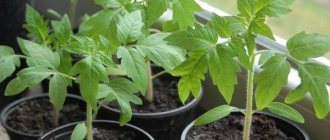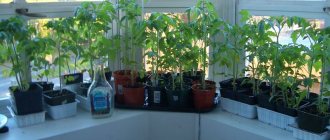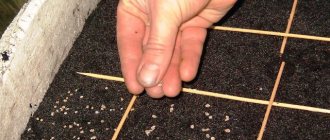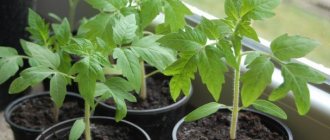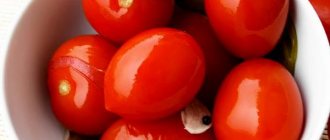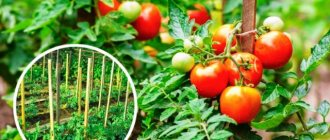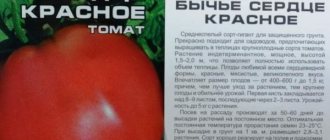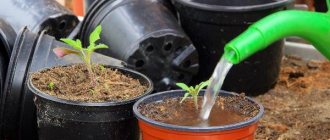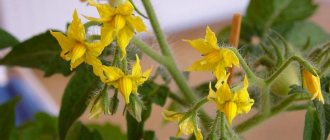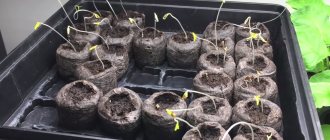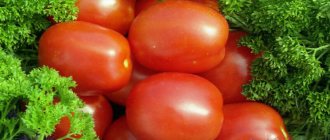Botanical description
The tomato (Lycopersicon esculentum Mill.) is an annual plant belonging to the nightshade family, which also includes the poisonous bittersweet nightshade and belladonna.
| Biological features | Photo |
| The tomato root system consists of a taproot, grows and develops quickly, and is about 1 meter long. Due to processing, in particular picking, the root is shortened, which leads to the formation of more lateral roots (the root system becomes fibrous). The underground part of the bush is located within a radius of up to 60 cm and grows to a depth of up to 90 cm. | |
| The tomato stem is pubescent, grows up to 40-200 cm, erect or lodging. The main stem initially grows vertically, then bends. In some dwarf varieties the bush remains erect. From the leaf nodes of the main shoot, lateral shoots of the first order (stepchildren) sprout, from them - of the second, etc. | |
| Tomato leaves are imparipinnate, grow oval, toothed, pubescent, and emit a characteristic odor. | |
| Tomato flowers appear 50-60 days after germination. They are yellow, bisexual, usually five-petaled, star-shaped. Mostly self-pollinating. It is collected in an inflorescence called a raceme, 5-20 pieces (usually 3-8). Depending on the variety, inflorescences can be single, double or compound. | |
| The tomato fruit is a berry, ripens 6-8 weeks after pollination. Characterized by a variety of shapes, sizes and colors. The color of the fruit depends on the content of pigments in the skin. | |
| Tomato seeds are flat, pubescent, gray-yellow or light brown in color, 3-4 mm long, 2.5 mm wide and 0.3-0.6 mm thick. The seeds are velvety, covered with hairs and small warts. 1 gram contains 300-350 seeds. Germination lasts up to 5 years. |
Seed preparation: disinfection and hardening
To begin with, it is worth examining exactly how the seeds were obtained. Many gardeners, in order to get a bountiful harvest next year, collect seeds from mature vegetables; they do not lose their viability for 8 years. But, if you want to try a new variety, then naturally you will have to buy purchased material, which should be prepared a little before planting. This should be started 1-2 days before sowing.
It all starts with the fact that we need to identify defective seeds. This is done as follows: take a small container of water and pour the fruits into it. Those seeds that are empty will float to the surface, while the good ones will settle to the bottom of the dish. We drain the water and begin disinfection.
This is done in several ways. Some people use a solution of potassium permanganate (1%), dissolving several crystals in a small amount of water until a deep pink hue is obtained. Then the selected seeds are placed in it for 20-25 minutes. Other gardeners, before growing seedlings, sterilize the fruits in a 5% saline solution by dipping them in it for 10 minutes. During this process, it is important not to mix seeds of different varieties. You can use small bags or non-woven material (napkin).
For seeds that are more than 3 years old and their germination rate has decreased, they will need to be soaked for 24 hours in a nutrient solution. For a liter of water we take a choice: a teaspoon of Agricola, Effecton, 1 ml of Epin or 2 grams of Bud. To prevent the seeds from mixing, use canvas bags. Make sure that the solution is not hot or cold - the optimal temperature for it is 20 degrees.
After preliminary preparation, the seeds need to be lowered to swell in a saucer under damp gauze at room temperature. If the fruits are less than 3 years old, we wait 8-10 hours; if they are older, it will take a little more time. Many gardeners harden the seeds before sowing them: place them in a plastic bag and leave them in the refrigerator for two days. Hardening stimulates the development of strong immunity and the emergence of friendly shoots.
The nutritional value
Tomato is a very important and valuable vegetable. Tomatoes are consumed fresh, for the production of concentrates, juices, sauces, ketchups, baby food, canned meat and fish, and soups. Tomatoes can also be pickled, canned, dried and dried.
Tomato fruits contain 5-8% dry matter, depending on the variety.
They also contain:
- vitamin C;
- provitamin A;
- B vitamins;
- red varieties contain more lycopene;
- yellow-colored varieties contain β-carotene.
Tomato is a low-calorie vegetable that can be successfully found in every person’s diet. It is not recommended to eat unripe green tomatoes, as they may contain substances that are toxic to the human body.
Varieties
Currently, mainly self-pollinating hybrids are grown. Varieties differ according to the following characteristics:
- duration of growing season:
- very early (95-105 days from germination to fruiting);
- early (105-115 days);
- moderate-early (116-135 days);
- late (after 130 days);
- growth type:
- superdeterminate (dwarf) – stems grow up to 40 cm;
- determinate - stems reach 70 cm, with each shoot ending in an inflorescence;
- indeterminate - have endless stem growth.
- form:
- round;
- flattened round;
- elongated;
- ribbed;
- smooth;
- fruit color:
- yellow;
- orange;
- crimson;
- red;
- black with shades of purple;
- fruit size (according to European standards):
- cherry 15-30 g;
- cocktail cherry 25-40 g;
- with small fruits 50-100 g, diameter 47-57 mm;
- with average fruits 100-150 g, diameter 57-67 mm;
- with large fruits 150-200 g, diameter 67-82 mm;
- with very large fruits 200-1000 g, with a diameter of more than 82 mm;
- usage:
- salad;
- cocktails;
- for canning;
- for the production of tomato juice.
You can read more in the article about Tomato varieties for open ground.
Before a red, juicy and aromatic tomato reaches our table, it must be provided with favorable conditions during the growth period and undergo a series of procedures. Only by knowing how to grow tomatoes correctly can you enjoy the delicious fruits.
Climatic requirements - temperature, air and soil humidity
In our country, due to climatic conditions, tomatoes are grown from May to October. Before growing tomatoes, you need to familiarize yourself with the temperature conditions for cultivating seedlings and adult bushes. Temperature conditions suitable for tomatoes are as follows:
- Temperatures of 2 °C are detrimental to tomatoes.
- Seeds germinate better at 14-16 °C, the optimal temperature is 18-20 °C.
- The tomato grows well with a temperature difference of 8-10 °C between day and night, the most suitable temperatures being 25 °C during the day and 17 °C at night.
- It takes approximately 30°C for flowers to appear and fruit to set.
When it comes to temperature fluctuations, unfortunately, tomatoes are sensitive to both low and high temperatures. A long cold season, unfortunately, can slow down plant growth and cause flowers to drop. On the other hand, on very hot days, when temperatures reach above 30 °C, plants do not produce lycopene, which is responsible for the red color of tomatoes.
It is better to choose a place protected from the wind for growing.
Tomato does not have significant requirements for air humidity, but develops better at a relative humidity of 50-60%. High humidity increases the risk of disease.
Soil moisture is more important for growth. At the initial stage of development of a tomato bush (and when growing seedlings), the soil should contain 70-75% NV, 90% NV when planting seedlings, 80% NV in subsequent stages. There is no need to maintain higher soil moisture, not to mention stagnant water, so as not to provoke the development of fungal diseases and plant death.
A tomato is a plant that requires two factors for proper growth - heat and sun. Therefore, it grows better in sunny places.
We grow tomatoes without seedlings - varieties, advantages and disadvantages of the method
Due to the short summer in many regions of our country, tomatoes have to be grown through seedlings. In spring, caring for seedlings takes a lot of time and effort, leaving no time for other things. Recently, many gardeners have been thinking about how to simplify the process of growing tomato seedlings, and some, in general, grow this vegetable using the seedless method. This method is not new; it has been used successfully in the southern regions for a long time. Today, gardeners in central Russia and even more northern regions are mastering the seedless method of growing tomatoes . We will talk about its advantages and disadvantages and about the varieties of tomatoes suitable for sowing in open ground in the article.
We grow tomatoes without seedlings - varieties, advantages and disadvantages of the method.
Soil requirements
Good soil guarantees a high yield. If we want to enjoy delicious tomatoes, we need to provide the plants with the right soil.
Best soils
The tomato grows well in many types of soil. Best soils:
- medium-heavy;
- rich in humus;
- rich in nutrients;
- well heated;
- moderately humid;
- neutral or slightly acidic: pH, pH 5.2-6.5;
- with high porosity and good structure;
- with an abundance of nutrients (see table);
- free of diseases, pests, weed seeds, toxic salts.
Table. Optimal content of macronutrients in soil for growing tomatoes (according to Rumpel)
| Macro component | Optimal content (mg/dm³) | |
| Soil for sowing | Soil for picking and planting | |
| nitrogen | 150 | 250 |
| phosphorus | 80 | 150 |
| potassium | 300 | 350 |
| magnesium | 60 | 100 |
| calcium | 1500 | 2000 |
Determinate varieties grow poorly on light, peaty soils; the best yields are observed on heavy, humus soils.
You can buy ready-to-use soil from a trusted source, or prepare the substrate yourself accordingly.
Soil preparation
To produce peat soil you will need:
- garden peat;
- chalk or dolomitic lime;
- multicomponent fertilizer.
Organic peat is acidic and therefore requires deacidification to a pH of 6.0-6.5. To do this, add chalk or dolomitic lime - usually 8 kg per 1 m³ of peat, the soil must be mixed well. Before decontamination, it is recommended to supplement the soil with nutrients using one of the multi-nutrient fertilizers, for example, azofoska, also keeping in mind micronutrients.
The deoxidation process can cause some elements, mainly phosphorus and potassium, to become insoluble forms and become unavailable to tomatoes. Peat soil prepared by hand can be used the next day.
A good soil can be created from a mixture of:
- clay soil (from a clover or alfalfa field fertilized with manure 100-150 t/ha);
- peat;
- coarse sand.
The mixture is made in a ratio of 2:1:1 for sowing or 7:4:1 for picking and planting. After mixing, add 2 kg/m³ of chalk and multi-component fertilizer according to the instructions on the package. When preparing seed soil for tomato seedlings, there is no need to use fertilizer.
The prepared soil is suitable for use only after decontamination.
In the case of growing seedlings in an apartment, in containers, you can use soil purchased at a garden store - a universal mix is better.
Soil disinfection
The soil can be disinfected chemically or thermally, the latter method is used more often. For thermal disinfection, steam is used to heat the soil to 95-100 °C - the treatment should last 20-30 minutes. The disadvantage of treating soil with steam is an increase in the concentration of the ammonium form of nitrogen in the soil, which is harmful to tomato seeds and plants in the initial growth phase, so the soil can be used after at least 2-3 weeks.
In the case of chemical disinfection, special preparations are used to combat pests, pathogenic microorganisms and weed seeds - provided that the soil moisture is good and the temperature is at least 10 °C. The procedure is carried out in accordance with the instructions on the label. Horticultural peat does not require decontamination; it is a sterile material.
Maslov method
This method is quite unusual, but among knowledgeable summer residents it is a huge success. At first, it’s hard to believe that tomato bushes planted horizontally will take root and actively bear fruit. The “tendrils” of the plant are completely unsuited for growing in an upright position. Therefore, breeder Maslov proposed at one time to create better conditions for the development of rhizomes. The scientist managed to collect almost 70 kg of ripe tomatoes per season. His followers came up with several variations of this method.
Fertilizers
Tomatoes grow better in the 2-3rd year after applying manure. In the first year after fertilizing, only dwarf varieties develop well.
When growing tomatoes, nitrogen fertilizers, phosphorus and potassium are especially important. When using organic fertilizers, the following doses of mineral fertilizers should be applied (based on soil analysis):
| Fertilizer, active ingredient | kg per 1 ha | gram per 1 hundred |
| N (nitrogen) | 100-150 | 1000-1500 |
| P205 | 80-100 | 800-1000 |
| K20 | 150-200 | 1500-2000 |
Nitrogen fertilizers are given in 2 doses:
- The first time before planting seedlings.
- 2 weeks after planting the seedlings.
In the case of fast-growing tomato varieties, the application of nitrogen fertilizers is divided into 3 parts. Doses of phosphorus and potassium can also be divided, but it is recommended to apply them completely before planting seedlings. Potash fertilizers should be applied to tomatoes in the form of potassium sulfate. It is recommended to fertilize with green nettle humus every 15 days, 2-3 times after planting the seedlings.
Lime should not be applied immediately before growing tomatoes because they are sensitive to it.
In autumn, magnesium or dolomite lime is applied at a dose of 30-50 t/ha (300-500 kg/area) for plowing.
Growing seedlings
In our climatic conditions, tomatoes are grown in seedlings.
When growing tomatoes, the seedless method is also used - sowing seeds directly into the ground. But it is only recommended in warm regions, requires additional work and may not produce the expected yield.
Seeding rates
Production of tomato seedlings lasts 50-60 days. It takes about 200-300 g of seeds per 1 hectare or 3-5 g per hundred square meters when growing seedlings. About 200 tomato seedlings grow from 1 g.
Tomato seeds are usually sown in boxes in the following quantities:
- 3 g per box;
- 3-4 seeds per pot with a diameter of 8-10 cm;
- 2 seeds per tray chamber, consisting of 54 flower pots per tray.
Collection and storage of tomato seeds
Seeds can be collected, but this only applies to varieties with established characteristics, that is, not hybrids. Seeds of some varieties can be collected annually. Tomato fruits are harvested as they ripen or once when ripe.
It is not recommended to keep seeds on the bush for too long, because they can germinate inside the fruit. Tomatoes from healthy bushes are collected and crushed. The pulp and seeds obtained in this way are placed in a saucepan and left to ferment for several days at room temperature.
Fermentation of tomato seeds can be facilitated by using the enzyme Pektopol P. Once a white coating (a fungus that protects the seeds from the attack of other pathogenic fungi) appears on the surface, remove the mold and place the seeds on a sieve, rinse under running water. The selected seeds are laid out in a dry, warm place to dry.
Peeled and dried tomato seeds should be placed in boxes or paper bags and stored in dry, ventilated areas during the winter, protected from mice, insects and light. Well-preserved seeds retain the ability to germinate for 5-7 years after collection.
Preparing seeds and soil
Before sowing, tomato seeds need to be treated against diseases and pests, and the soil must be steamed 2-3 weeks before sowing.
Good soil for tomatoes includes:
- 1/3 humus,
- 1/3 fertile soil,
- 1/3 peat or perlite.
Sowing dates and sowing
The sowing date depends on the variety, the date of planting the seedlings in open ground and the planned date of harvesting the tomatoes. It should be remembered that from sowing seeds to obtaining seedlings is about 6 weeks.
Tomato seeds are sown in spring - from late February to May, and for later harvest even in July. When planning to sow seeds for seedlings, from March 15 to April 1, they are sown in pots at a distance of 10x3 cm to a depth of 1-1.5 cm.
In warmer regions of the country, you can also sow directly into the ground at the turn of April and May. Sowing in a greenhouse usually occurs at the turn of April-May and is carried out in a greenhouse or tunnel, where the temperature should be 18-20 °C.
Seeds are sown in the ground and watered with water. Containers prepared in this way can be covered with perforated film or a glass plate until the plants germinate. Tomato seeds germinate very easily. At 20-25 °C they begin to germinate in about 3-6 days. Seeds are sown in small sowing containers; peat pots are popular.
It is important to reduce the temperature after germination and maintain it at 15-18 °C.
After tomato seedlings emerge, the recommended temperature is 18-20 °C. Tomato seeds do not germinate at soil temperatures below 8 °C. In addition to the correct temperature, it is important to ensure the correct soil moisture.
Picking
After the appearance of the first true leaf, the plants are planted in pots with a diameter of 8-10 cm, filled with soil of the same composition as for sowing. Seeds can be sown directly into pots to reduce the hassle of picking, but this does not guarantee better plant development and high yields.
Seedlings can also be planted in a tunnel with heated soil. The distance between plants in this case is 10x10 cm.
When sowing seeds directly into the tunnel, observe the following planting scheme:
- between rows – 10 cm,
- in rows - 3 cm.
The sowing date for tomatoes is late April-early May. Direct seeding into a tunnel is usually used on large farms.
Hardening
Tomato seedlings need to be hardened off before planting by limiting watering and using intensive ventilation for about 7 days. A good seedling that can be planted should, depending on the variety, have a height of 15-30 cm and 5-8 leaves.
Planting seedlings in the ground
If the seedlings are purchased, you should choose them correctly. The diagram below shows signs of how to distinguish healthy tomato seedlings from diseased, low-quality ones.
Before planting tomato seedlings in the ground, you need to water it generously; this will help you carefully remove the plant from the pot without damaging the roots. Planting in the ground is carried out in the second half of May, after the last spring frosts. The soil needs to be prepared as described above. The plant is placed in the soil so that the first leaves are located above the surface and do not touch the ground. After planting in the ground, tomatoes should be watered generously, then sprinkled with dry soil and carefully compacted.
The best conditions for planting seedlings are cloudy, but not rainy, weather. If there are only sunny days, it is better to plant seedlings in the evening.
Tomatoes are usually planted in rows. Planting density depends on the tomato variety and soil type:
- for early varieties, an interval of 80 × 40-50 cm is used;
- for late varieties 80-100×50-80 cm or 80×80 cm;
- for low varieties - 40-60 cm by 30-50 cm, with the distance between rows being 40 cm, a path is made on every fifth row;
- for tall varieties, the distances are made a little larger - it is about 50 cm between plants in a row and 1 m between rows;
- dwarf varieties are planted more densely.
After selecting a suitable distance and marking the landing sites, sticks about 1.5 m high are driven into the ground and holes are prepared. Tomatoes are planted a little deeper than they were growing in pots, so that the first leaves are just above the surface of the soil. The soil around the bushes is raked, a small depression is created around the stems and watered abundantly. If the site is too exposed to wind, individual plants can be further protected from it by using covers, such as thin boards.
Curved and elongated tomato seedlings are planted in an inclined position and deeper. A stem buried 5-7.5 cm in the ground will produce roots.
Mr. Summer Resident: secrets of getting rich tomato harvests
Every gardener has his own secrets for growing tomatoes, here are some of them:
- Tomatoes are self-pollinating plants (most varieties). But unfavorable conditions can arise when this process is not carried out well. Then it is necessary to shake the plants 1-2 times a week during the flowering period.
- To increase the yield of the second and third clusters, they are sprayed with a solution (in low concentration) of boric acid during the flowering period. This improves the formation of ovaries.
- If you add fertilizers (manure and peat) to the soil in the fall, then it will be better prepared for growing a bountiful harvest, having rotted over the winter.
Non-standard ways to grow tomatoes
Gardeners use various methods to grow this vegetable. It is worth remembering that not each of the above methods will be applicable to all regions of our large country. In some places, a number of methods will be unacceptable, since, for example, in Siberia it is very cold, and even summer is not a guarantee of a good harvest. Features of the choice of method are not limited to the territorial location of the site where tomatoes are supposed to be grown. Some people don’t have this area at all, due to certain circumstances. However, if you equip the appropriate corner, more choice will open up.
Each method is determined by the characteristics of the growing site and the personal wishes of the gardener.
Lazy (tomato grove)
In fact, it is completely similar to the traditional growing method. However, there are significant differences. In the standard method, plants are planted in a row, with a large distance between each other. This is done so that each individual bush has its own space, from which it is fed with moisture, various nutrients, and fertilizers.
The method in question can significantly reduce the time for planting, as well as reduce the waste of energy and time on subsequent care. The first step is to dig holes, approximately 0.3 m deep and 0.5 m wide. The bottom must be loosened with a pitchfork or something convenient for the gardener. This is done to make it easier for the roots to grow. Next, you need to place a stake, or just a strong stick, exactly in the center. The height should be at least 2 m. Then the dug holes begin to be filled with layers of fertilizer. First comes a bucket of manure, it is important that it is rotted. A bucket of humus, then a bucket of sand. The remaining space is filled with excavated soil.
After all the filling operations have been carried out, the “contents” of these same holes must be mixed. You can, of course, mix all the ingredients in advance in a separate container, but, firstly, it will be much more difficult, and secondly, it will be time-consuming. After this, you need to make borders around it from the remaining earth.
Up to 5 bushes can be planted in one hole, it is important that they are of the same variety. The stems are tied to a stake driven into the center in advance.
This method is also very good because of the availability of moisture for the plant; it will have the opportunity to receive it from deeper layers of the earth than with conventional planting. Mixed soil with fertilizers will ensure uninterrupted supply of nutrients for favorable ripening. Most types and varieties of tomatoes can be planted in this way.
Maslov method
Tomato stems have the ability to form a new root system and become an independent plant. In this method, all actions are standard, but with one nuance. The seedlings are placed in the soil along with the stem. In this case, the roots of the plant are directed to the south. Only about 4 leaves should remain above the ground. Thanks to this method, the ripening process is faster, and after a while the side shoots turn into independent plants, which ensures a larger harvest. Gardening experts recommend a so-called drip irrigation system for this method.
On a leash
The main condition for this method is tall varieties of tomatoes. The method allows you to significantly simplify all operations for harvesting and caring for plants. Twine is used as a support, which is attached to the top of the greenhouse, or to the crossbars (if any).
Chinese method
Based on a specific phase of the moon, the constellation Scorpio.
At this time, the preparation of planting material and planting of seedlings takes place. Then the seedlings, when they are about 3 cm tall, are cut off, placed in Epin’s solution and planted again in a nutrient substrate, watered with the same. Cover with a glass and place in a dark place for 3 days. In the future, they are cared for as for ordinary seedlings.
The advantage of this method is a significant increase in yield, in fact 2 times. The stems become thicker, much stronger, and the tomatoes are less susceptible to disease.
Bucket growing method
Quite popular, it has a number of advantages, but is not without its disadvantages. It is very economical in terms of space taken up on the site, as it allows you to move the plant. The consumption of water and fertilizers is reduced, since they do not dissolve in the soil, but are contained in a limited space. With all this, the size of the harvest will not decrease at all.
Another advantage is that you don’t have to deal with pests, since they simply won’t reach the tomatoes grown this way. A dubious drawback is daily watering. Why doubtful? Because it is the only one, and it is more than covered by the advantages of this method.
Ampel method
For this method, a certain type of tomato is used, which produces small, tasty and juicy fruits. The peculiarity is that the stems of this variety are thin, but not at all fragile. They are very strong and can grow up to 1 m in length. The shoots do not break, this is due to the small size and weight of tomatoes. The harvest is significantly less than that of ordinary tomatoes, but the huge advantage is that it can be obtained all year round. In addition, they are easy to grow in an apartment. This is an excellent solution for those who do not have a separate plot of land, or, due to workload, cannot afford it, but want to engage in cultivation. In addition, this type of tomato is very decorative and looks beautiful. A year-round harvest is ensured due to the very rapid ripening of new fruits in place of those collected.
When planting, they require exactly the same care as regular tomatoes. Gardeners recommend placing them where there is the most sunlight; a balcony is ideal in the summer, and a window sill in the winter. They require very frequent watering, at least 2-3 times a day. Organic matter is an excellent fertilizer. They get along in the same pot with other plants. Some recommend planting sage along with them. This allows you to improve the aroma and taste of grown tomatoes.
There are several varieties of hanging ones. All of them are precocious, not particularly whimsical, lovers of sunbathing. The fruits of this species are very sweet, children love them most.
Upside down
At first glance, this is a rather strange, even crazy type of cultivation. However, this also happens, and it has clearly gained popularity and recognition in certain circles of gardeners. The point is that the plant itself is directed downwards. This is done by using a small hole in the pot through which the stem is threaded. There are a lot of advantages, the most significant are the absence of the need to tie up the bush, the need to bend over for ripe fruits is lost. Which is very important for older people, as well as people with back problems. There is also an “upgrade” to this method.
A tomato in a pot is placed in a greenhouse specially created for the size of the bush and pot. This provides the plant with more favorable conditions for ripening and increases yield. However, this is not suitable for types and varieties of tomatoes that love sunlight very much.
Hydroponics
The method is extremely simple, and has been very popular since the middle of the last century. The point is that a pot with a plant is placed in another pot. Which contains the nutrient solution. In a pot with a plant, several holes are made at the bottom so that the roots have access to this very nutrient solution. After some time, it is better to set the frequency; the pots must be pulled out. This is done to control the growth of the root system.
Immediately after the roots of the plant have passed through the holes made, it is necessary to reduce the volume of the nutrient solution in pot 2 so that an air cushion is formed. This is to ensure that the roots are constantly in a humid environment and receive the required amount of oxygen. The advantage of this method is the enormous stimulation of the growth of the root system, which affects the growth of the plant itself, and as a result, the yield.
Most methods not only save time, but also provide a larger harvest. Which naturally affects profits (for those involved in sales). Even if you don’t sell it, you can supply all kinds of relatives and friends with tomatoes; they will be extremely grateful for real, fresh, and especially free tomatoes.
Growing and care
Pruning and shaping the bush
The first and most important activity is pruning and shaping the tomato bush so that all the strength of the plant does not pass into unproductive shoots, but is directed into the fruits. Pruning begins by shortening the main shoot above the second inflorescence. Then, the topmost side shoot is pruned in the same way when it produces a second inflorescence. All emerging branches are sequentially removed, and during the fruiting period care is taken to prune young shoots (stepchildren) growing from the leaf axils.
Pruning tomatoes will have a positive effect on fruit growth and will significantly improve their quality.
Garter
The next step is tying the tomato bushes to stakes, another support. This is possible when the tomatoes have grown enough - 2 weeks after planting. The garter is performed freely, the rope is placed below the inflorescence. To grow fast-growing tomato varieties, you need to prepare 1.5-meter stakes. Dwarf tomatoes are usually not tied to supports, although in small plantations, supports make the tomatoes easier to care for.
Growing tomatoes on a trellis
At a distance of about 10 cm from the plant, 1.5-meter poles are buried, and a trellis (wire) is pulled between them. The stems are not tied too tightly to the trellis. Most often, the method is used for fast-growing varieties, but there are no contraindications for gartering dwarf varieties.
Mulching
Caring for tomatoes includes mulching the soil. Mulching will speed up and increase the fruiting of plants. A few centimeters of mulch is spread between the rows. The operation is performed at the turn of May-June. The timing of mulching tomatoes is not chosen by chance - the soil must be adequately heated. If the cool season lasted a little longer, you might want to wait a few days. The litter should not be laid out earlier than in the last ten days of May, otherwise the soil will warm up more slowly.
For mulching, the soil is covered with:
- straw,
- sawdust,
- peat,
- leaves,
- black film (best choice).
Mulching helps limit weed growth by maintaining optimal temperatures near the roots and proper soil moisture.
Removing leaves and ovaries
Leaves that touch the soil surface, dry leaves and dried ovaries must be removed.
Trimming and removing excess ovary is carried out with a decisive movement, without tension - this treatment is carried out only in indeterminate varieties.
Watering and weeding
Tomatoes are harmed by both excess and lack of water. The harvest is adversely affected by too little rainfall during flowering, especially at the turn of July-August, which can lead to the fall of flowers and ovaries, and drying out of plant parts. Heavy rain during the ripening period can cause the fruit to crack.
During drought, tomatoes should be watered regularly and abundantly - once a week, using one dose at the level of 200-400 liters of water per hundred square meters.
How to save tomatoes from frost?
Irrigation of tomatoes is aimed not only at providing the water the plants need during the growth process, but also helps protect the bushes from hypothermia due to frost. It should be started when the surface temperature drops below 0°C. During this period, irrigation should be quite intense; a dose of 300 liters of water per hundred square meters per hour, poured through a sprinkler, is sufficient. If the temperature drops from -1° to -8°, the dose of water should be doubled. Sprinkling should continue until the air temperature at the surface of the earth rises above zero.
In warm weather, water the tomatoes with warm water at the base, carefully without wetting the leaves.
It is necessary to regularly carry out manual weeding; the use of herbicides in amateur cultivation of tomatoes is unnecessary.
Processing flowers to form an ovary
To speed up fruit set and increase yield, flowers are treated with a special solution. If the temperature during the flowering period is lower than the optimal growth temperature (18-25 °C) and is 10-15 °C, a special procedure is recommended. Treatment helps plants bear fruit better and increases productivity. To do this, in cold weather, flowers are sprayed with 0.5% Betoxone R or 0.2% Betoxone Super, nicotinic acid, thiamine. Treatment of tomato flowers should be repeated after 3-5 days.
Feeding
Before applying fertilizers, a chemical analysis of the soil composition must be carried out, but in the conditions of a summer cottage this is unprofitable. If the soil quality on the site is poor, it is worth considering the possibility of applying mineral fertilizers. During the growing season, tomatoes are fed using several ingredients or individual fertilizers.
Lack of elements has certain symptoms.
| Symptoms | Causes |
| Unreasonable inhibition of growth, discoloration of plants | Phosphorus deficiency |
| Insufficient coloring of tomato fruits and bending stems that are not strong enough to support the weight of the fruit | Potassium deficiency |
Pests and diseases
It is necessary to systematically inspect the plants in order to notice diseases and pests in time and carry out appropriate treatment.
Main diseases of tomatoes:
- brown rot;
- late blight;
- potato rot;
- tomato Alternaria;
- bacterial cancer;
- black bacterial spot;
- brown spot;
- macrosporiosis;
- septoria;
- mosaic;
- streakiness;
- stolbur;
- black rot of tomatoes;
- downy mildew.
Tomato pests:
- springtails, or springtails;
- aphid;
- Colorado beetle.
What varieties of tomatoes can be grown without seedlings in the middle zone?
Tomato varieties should not only be very early, but also cold-resistant, resistant to diseases and temperature changes. It’s good if the packaging with seeds says: “Suitable for growing without seedlings.” But there are few such varieties, among them: “Amur Standard” , “Bezrassadny (Sprint-2)” , “Spring Frosts” , “Explosion” , “Far North” , “Subarctic” , “Yamal” .
In addition to these varieties, you should pay attention to the following varieties. They belong to the early and super early varieties, are unpretentious in cultivation, and are resistant to weather changes:
- "Iceberg" - early, cold-resistant, resistant to temperature changes.
- “Juggler” from breeder L. A. Myazina is drought-resistant, heat-resistant, and resistant to low temperatures.
- "Leopold" is ultra-early ripening, cold-resistant, undemanding to care, resistant to major tomato diseases.
- “Duckling” is early, disease resistant. It is distinguished by good fruit set even in unfavorable conditions and uniform fruiting.
- “Lollipop” tomato is incredibly unpretentious and productive; it belongs to very early varieties.
- “Leningrad Chill” is super early and has exceptional cold resistance.
- “Severyanin” is an ultra-early plant that sets fruit well at low temperatures.
You can also sow tomato varieties “Boni MM” , “Flash” , Gnome , “Sanka , “Bullfinch” , “Snowdrop” , “Shuttle” , “Apples on the Snow” .
When the tomato seedlings have 2-3 true leaves, you will need to leave the strongest sprout and remove the rest.
